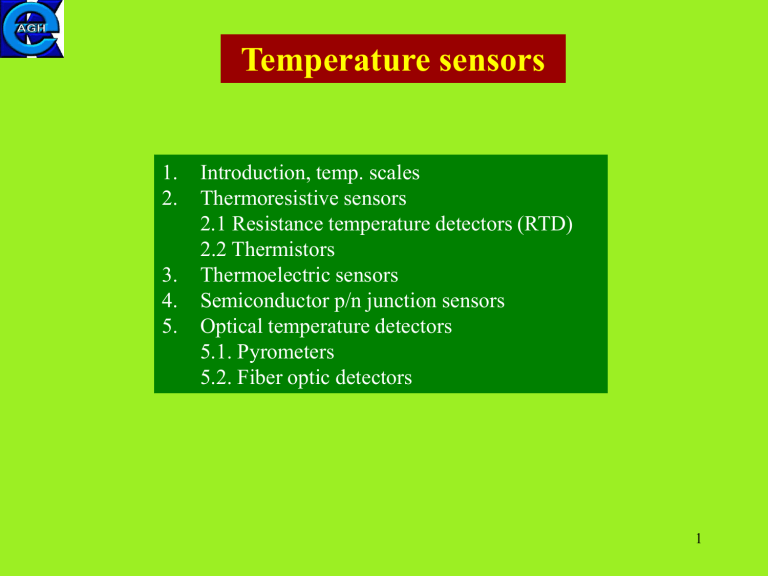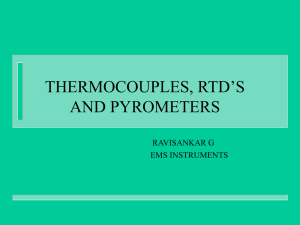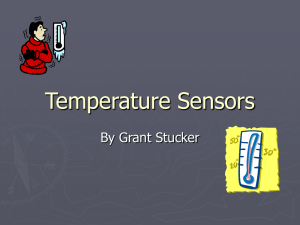Prezentacja programu PowerPoint

Temperature sensors
1.
Introduction, temp. scales
2.
Thermoresistive sensors
2.1 Resistance temperature detectors (RTD)
2.2 Thermistors
3.
Thermoelectric sensors
4.
Semiconductor p/n junction sensors
5.
Optical temperature detectors
5.1. Pyrometers
5.2. Fiber optic detectors
1
Introduction
From historical point of view the most widely used phenomenon for temperature sensing was expansion (mercury thermometers).
At present one uses detectors with electrical signal at the output.
Temperature detectors can be classified basing of several criteria.
From the point of view of generated power we have:
• generation-type sensors (eg. thermoelectric)
• parametric-type (eg. resistance R(T), magnetic μ(T), dielectric ε(T))
From the point of view of other criterion we have:
• contact-type sensors (eg. thermoresistors)
• noncontact sensors (eg. pyrometers)
In practice we expect that temp. sensors will be:
• accurate (for a given temp. range)
• reliable (important in process control)
• inexpensive (in consumer applications)
2
Growing perspectives of temperature sensors :
• expansion of layer technologies and micromachining
• increased application of fiber optic sensors
• increased role of microprocessors and sensors with digital output.
Temperature scales
• Celsius scale (1742)
Based on two equilibrium points of water: freezing (0 0 C) and boiling (100 0 C)
• Thermodynamic scale
Based on the Carnot engine
T = T tr
· Q/Q tr
Q – heat absorbed from the source of temp.T
Q tr
– heat discharged to the source of temp.
T tr
= 273.16 K
• International Temperature Scale 1990 (ITS90)
Based on thermodynamic scale which is conneted with Celsius scale as follows: t( o C) = T(K) – 273,15 then 1 o C = 1K.
There are introduced 17 fixed points (phase equilibrium points) with defined temperatures, interpolation formulae between the fixed points and 4 standard thermometers for temperature measurements. For example between the triple point of equilibrium hydrogen (13.8033K) and the freezing point of silver (961.78 0 C) T90 is defined by means of platinum resistance thermometer.
3
Thermoresistive sensors
Thermoresistive sensors can be divided into metallic - type, called RTD (resistance temperature detectors) and semiconductor - type known as thermistors.
Metallic temperature detectors (RTDs)
The resistance of metallic snsors in a narrow temp. range can be given as a linear dependence:
R(t) = R o
[1 + α(t - t o
)]
α – temp. coefficient of resistance TCR
R o
– resistance at t o
(mostly 0 o C or 25 o C)
In a wider temp. range higher order polynomials should be used.
For example for platinum the good approximation in a range fom 0 0 C to 850 0 C is a second order polynomial (PN-EN 60751 in accordance with ITS90):
R(Ω) = R o
(1 + 39,083·10 -4 T – 5,775 ·10 -7 T 2 )
R o
– resistance at 0 0 C
T – temp. in Kelvin scale
4
RTDs, cont.
The requirements for metallic thermoresistors are as follows:
• high sensitivity, i.e. high α
• linearity (constant α )
• miniaturization (high resistivity ρ)
• chemical inertness and long-term stability
Metal
Al
Ag
Au
Cu
Ni
Pd
Pt
Ta
W
Zn
Resistivity ρ [μΩcm] at
20 o
C
2,65
1,6
2,24
1,67
6,84
10,5
10,6
12,4
5,6
5,9
Resistivities and TCR for selected metals
TCR α [1/ o
C]
0,0039
0,0061
0,0034
0,0039
0,0069
0,0037
0,0039
0,0038
0,0045
0,0042
5
Platinum resistance thermometers
Platinum is the most popular material for resistance thermometers.
Pure Pt is obtained in a form of wires with a diameter lower than 0.05mm, what is necessary to obtain the required magnitude of a thermometer resistance.
A lot of possibilities give thin and thick film technologies, which reduces the sensor fabrication costs.
Typical Pt sensor is known as Pt100 (100 Ω at 0 o C).
Relative resistance of a platinum wire given as: R
100
/R o
= 1 + α Δt is a measure of TCR and depends on wire purity.
For a very pure Pt wire one obtains: in a precise thermometry one uses:
R
R
100
100
/R
/R o o
= 1,3927
= 1,3910
6
Platinum resistance thermometers
In USA SAMA standard for Pt α value specifies : R
100
/R o
In Eurpe the standard for Pt thermometers in technical applications (DIN 43760, IEC 751) is: R
100
/R o
= 1,3925
= 1,3850
IEC standard defines additionally two classes of precision for Pt thermometers:
A for the range -200 do 650 o C (more rigorous) possible error [ o C]: ±(0,15 + 0,002|t|)
B for the range -200 do 850 o C possible error [ o C]: ±(0,3 + 0,005|t|).
Typical dimensions of Pt wire thrmometers:
3,2 x 10 mm dla 100 Ω, 500 Ω, 1000 Ω
2 x 10 mm dla 100 Ω, 500 Ω, 1000 Ω
2 x 2,5 mm dla 100 Ω
1 x 5 mm dla 100 Ω
Outside view of Pt wire thermometers
7
Thin film Pt sensors
Thin film of Pt is deposited on the ceramic substrate and the resistance corrected for the required magnitude.
Laser cut thin film of platinum with bonded lead wires (view of a sensor without covering protective layers).
Ready for use thin film Pt thermometer
8
Semiconductor resistance temperature sensors
(thermistors)
Thermistors are mostly obtained as sintered oxides, sulfides and selenides of elements such as Co, Mn, Ti, Fe, Ni, Cu, Al, fabricated in a form of bars, droplets, discs and also thick films.
Thermistors can be divided into two groups:
NTC (negative temperature coefficient)
PTC (positive temperature coefficient).
Characteristics of NTC and PTC thermistors as compared to metallic RTD thermoresistors.
9
NTC thermistors
Conventional oxide resistors have a negative TCR and their resistance as a function of temperature can be written with a good approximation as:
R
T
= A exp [β/ T]
Constant A depends on sample dimensions, β is a material constant which determines the sensitivity (β = 3000 – 4500K).
Introducing the reference resistance R ref at a reference temp. T ref
= 25 o C, one obtains
R
T
= R ref exp [β(1/T – 1/T ref
)]
The values of R ref vary in a range: 500Ω – 10MΩ.
In a wide temp. range the sensitivity is better characterised by TCR:
α = 1/R
T
· dR
T
/dT = - β/T 2
The values of α are ca. 6 – 10 times higher than those for metals but decrease quickly with temperature.
10
Measurements of thermoresistors resistance
U out for
R
T
IR
/ R
R
U z
R
R
T
1
U out
U z
( 1
R
T )
R
Compensation of leads resistance (in this case 1 and 3)
1,2,3 – identical thermoresistor leads
11
Thermoelectric sensors
For this kind of sensors the generated thermo EMF is based on the Seebeck effect.
Seebeck effect (1821)
In a circuit consisting of two conductors A and B, which junctions have temperatures T
+ ΔT and T, the thermoelectric voltage is generated and a thermoelectric current is flowing.
A(+) – metal A positive in respect to B
For a given conductor the absolute Seebeck coefficient is defined as: a dV dT and connects the generated electric field E a with temperature gradient
E a
a
T
12
Thermocouples
As the thermocurrent flows in a circuit consisting of at least two different conductors, the differential Seebeck coefficient is introduced a
AB
a
B
a
A and accordingly dV
AB
a
AB dT
For the small temperature change we can then write
V
AB
a
AB
( T
T
0
)
If temperature T
0 of the reference junction is known then from the measurement of thermovoltage V the temperature T of a measurement junction can be determined
(thermocouple).
In practice we do not use α which is temperature dependent but in calculation of a thermovoltage for a given thrmocouple we exploit the tabulated values.
Example :
Calculate the thermovoltage for Au-Pd thermocouple in the case t
0 given thermovoltage for a junction Au-Pt: +1,84 mV
= 0 0 C, t = 200 0 C: given thermovoltage for a junction Pd-Pt : - 1,23 mV
Calculated thermovoltage for Au-Pd thermocouple: 1,84 – (-1,23)= 3,07 mV
13
Thermocouples
Thermocouples widely used are standardised. They are manufactured from alloy materials with compositions which are often restricted by the producer.
Designation (ANSI)
E
Materials
Chromel/Constantan
J
K
Fe/Constantan
Chromel/Alumel, known also as NiCr/NiAl
T
R
S
B
Cu/Constantan
Pt/Pt-13%Rh
Pt/Pt-10%Rh
Pt-6%Rh/Pt-30%Rh
Properties of K-type thermocouple:
• 1-st thermoelectrode NiCr (+) , composition: 85% Ni, 12% Cr and other elements in small quantities
• 2-nd thermoelectrode
NiAl (-) , composition: 95% Ni, 2% Al, 2% Mn, 1% Si,
• nearly linear thermometric characteristics,
• resistant to oxidizing atmosphere, at elevated temperatures sensitive to reducing atmosphere,
• working temp. range from – 270 0 C to 1150 0 C, average sensitivity 41 μV/K.
14
Thermocouples
Typical thermocouples are manufactured in insulation.
With the help of micromachining technology the thermocouples are manufactured on membranes. The small heat capacity and good thermal isolation enable the registration of infrared radiation spectra.
In the solution shown in the figure the cold junction is placed in the area of a good heat conductivity.
The hot junction is placed in a central part of a membrane with low thermal conductivity.
Additionaly the hot junction is placed under the IR absober. Serial connection of thermocouples, called the thermopile, enhances the sensitivity.
15
Measurements with the help of thermoelements
The basic measurement circuit of a thermocouple.
Reference junction temperature variation introduces the measurement error.
In a reference temp. 0 0 C one measures ε t
.
In a reference temp. t r one measures ε a
= ε t
- ε r
Compensation of reference temperature variation
1.
The reference junction is put at a distance from the heat source with the help of compensation leads
PX, NX - the leads with thermoelectrical properties identical with those of thermoelements
(for PtRh-Pt one uses alloys of copper and nikel).
16
Compensation of reference temperature variation, cont.
2. One uses a thermostat stabilising the reference temp., eg. 50 0 C .
Traditionally a reference ice bath was used to maintain 0 0 C, which presents some limitations for the practical uses.
3. Automatic correction of the influence of reference temperature variation
The reference temp. increases from t
0
Response of a thermometer:
R t
= R
0
[1 + α (t
1
– t
Response of a thermocouple:
0
)]
Δε = k (t
1
– t
0
) to t
Compensation condition: Δε = - U
N
The compensation condition is fulfilled
1
.
if U z
= 4k/α
4. Actual temperature is calculated by a microprocessor as: t = t d
+ C t r t d
, t r
– measured temp., C – thermocouple constant
17
Pyrometers
This kind of thermometers is used for distant (noncontact) measurements of temperature.
It is based on the analysis of thermal radiation emitted by the objects.
Monochromatic pyrometers are used as standard thermometers from the freezing temp. of silver (961,78 0 C).
Classification of pyrometers:
• total radiation pyrometers (wide bandwidth)
• monochromatic pyrometers
• two-color pyrometers
• multicolor pyrometers
Basic laws of thermal radiation
• Planck’s law
Radiation flux density, i.e. power of radiation per unit of area and unit of wavelength
(Wm -2 µm -1 ) is equal:
5
( e c
1 c
2
/
T
1 )
λ- wavelength, c
1
ε
λ
,c
2
– radiation constants
–monochromatic emissivity of a source
(for a blackbody equal 1)
18
Pyrometers, cont.
•
Stefan-Boltzmann law
Radiation is absorbed by the detector in a limited range of wavelength. Integration of the
Planck’s formula vs. wavelength gives a power per unit of area which is emitted by the object with temperature T
b
T
4
σ = 5.67x10
-8 W/m 2 K 4
ε - emissivity, depending on the surface condition and temperature
Above formulae, called S-B law, is a base of the wide band pyrometry.
In the analysis of radiation exchange between an object and a sensor the radiation reflected and emitted by the sensor must be taken into account. This leads to the dependence:
s
( T 4
T s
4 )
ε
S
, T
S
– emissivity and temp.
of a sensor
19
Two color pyrometer
The analysis of radiation flux density Φ
λ for neighbour wavelength one can write as a function of source emissivity ε indicates, that x
0 .
4 y
0 .
4
x
0 .
7 y
0 .
7
x
1 y
1
Therefore measurement of a signal in two neighbour narrow spectral ranges elliminates the necessity of determination the source emissivity ε.
This is a base of the so called two color pyrometry.
Emission spectrum for the source at temperature of
600 o C and for three different emissivities
ε 20
Two color pyrometer
Pyrometers construction
Wide band pyrometer
For this purpose photonic detectors
(photovoltaic or photoconductive) are developed,
λ
1
, λ
2
– determine narrow bands placed in a neighbourhood.
Thermal detectors are used (bolometers or thermopiles).
Wide band entrance window is necessary.
Four colour pyrometers were developed for uses where the emissivity is very low and not stable during processing. Four color pyrometers measure the radiation intensity simultaneously in four different spectral areas and they are able to adapt and make a correction of the emissivity setting.
21
p/n junction as temperature sensor
Semiconductor p/n junction (of eg. diode connected transistor) is polarized in a forward direction.
I = I
S
[exp(qU
BE
/kT) – 1] for qU
BE
>> kT
U
BE
= (kT/q) ln (I/I
S
) = f(T) for I = const one obtains quite good linearity in a range from - 50 0 C to + 150 0 C
For silicon bipolar transistors the sensitivity is equal
∂ U
BE
/ ∂ T ≈ - 2,25 mV/K for T=300 K and I=10 μA
However the saturation current I
S depends weakly on temperature which gives the nonlineatity error. This error is quite small and in many cases no linearity correction is required.
Better linearity one obtains in a differential configuration.
22
p/n junction as temperature sensor, cont.
Voltage drops at the junctions powered from constant current sources are equal
U
F 1
kT ln q
I
F 1
I
S 1
U
F 2
kT ln q
I
F 2
I
S 2
The differential voltage is equal
U
U
F 1
U
F 2
kT q ln(
I
F 1
I
F 2
I
S 2
I
S 1
)
kT q ln(
I
F 1
I
F 2
J
S 2
J
S 1
A e
A e 1
2 )
For a given technology of transistors one can assume that emitter current densities are equal
J
S1
= J
S2
.
Labelling the emitters cross-sections ratio as r = A
S2
/A
S1 one obtains
U
kT ln( q
I
F 1
I
F 2
r )
For I
F1
= I
F2 q
23
Junction as temperature sensor, integrated circuit
The circuit in the figure illustrates the practical solution of the described differential method employing semiconductor p/n junctions.
This system is often manufactured as integrated ciruit in a silicon substrate in monolithic sensors requiring temperature compensation
(eg. in micromechined membrane of pressure sensors).
Transistors Q
3 i Q
4 form the so called current mirror which secures the equality of currents
I
C1
= I
C2
= I
Drop of voltage V
T on resistor R is equal
V
T
V be 1
V be 2
I
T
R
2
k q ln r
T and then is proportional to the absolute temperature.
The sensors of this type are called PTAT (proportional–to-absolute-temperature) sensors.
24
Fiber optic detector
Optical temperature sensors
With the increse of temperature, semiconductor absorption edge shifts to the longer wavelengths and the transmitted light intensity decreases.
Emission spectrum of the source diode is also shown.
Light intensity decreases after passing the seniconductor.
25







